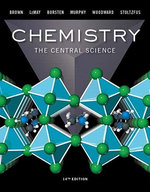Consider the data presented in Exercise 14.20. (a) Determine whether the reaction is first order or second order. (b) What is the rate cons
Chapter 14, Problem 14.48(choose chapter or problem)
Consider the data presented in Exercise 14.20.(a) Determine whether the reaction is first order or second order.
(b) What is the rate constant?
(c) What is the half-life?
Unfortunately, we don't have that question answered yet. But you can get it answered in just 5 hours by Logging in or Becoming a subscriber.
Becoming a subscriber
Or look for another answer
